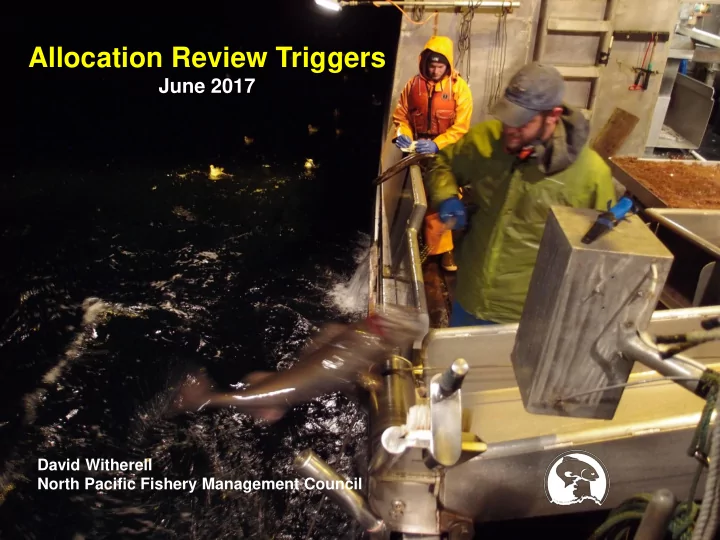

Allocation Review Triggers June 2017 David Witherell North Pacific Fishery Management Council
Outline Overview of the Fisheries Allocation Review Policy Determining applicable NPFMC allocations Pros and Cons of different types of triggers for review Findings relative to meet the policy requirements Discussion of next steps
Fisheries Allocation Review Policy Policy Directive 01-119 The policy requires that fisheries allocations are periodically evaluated, and are adaptive to ensure that OY is being achieved under current conditions. Allocation reviews can be triggered by one or more of the following: 1) public interest criteria, 2) time-based criteria, or 3) performance indicator criteria. The Councils must determine the trigger(s) applicable to each fishery. Councils have up to 3 years to identify these triggers in a policy document or FMP amendment.
Fisheries Allocation Review Policy Definition of Allocation Fisheries Allocation (or “allocation” or “assignment” of fishing privileges) is defined by NMFS as a “direct and deliberate distribution of the opportunity to participate in a fishery among identifiable, discrete user groups or individuals.”
Applicable NPFMC Allocations Established Program Allocation by LAPP ? Review American Fisheries Act Congress Yes 2017 Aleutian Islands Pollock Congress Yes 2017 BSAI Crab Rationalization Congress Yes 2016 Community Development Quota Congress NA Amendment 80 Council Yes 2015 Halibut / Sablefish IFQ Council Yes 2016 Central Gulf of Alaska Rockfish Council Yes 2017 GOA Pacific Cod Sector Allocation Council No BSAI Pacific Cod Sector Allocation Council No Halibut Catch Sharing Plan Council No
Types of Triggers Trigger Description PROs CONs Criteria Allows the public to Most responsive to Sets up public Public request reviews through: perceived or slight expectations. Vulnerable Interest- 1) ongoing input, 2) changes in fishery to political or council based solicitation by Council for performance. dynamics (reviews might input, or 3) by formal Council can never happen, or occur petition. determine schedule frequently causing fishery for solicitation of instability and increased input. staff workload). Time-based Requires periodic Simple and Not sensitive to allocation review; Directive unambiguous. Not competing Council suggests every 7-10 vulnerable to priorities for staff time years. political or council and meeting agendas. dynamics. Indicator- Requires an allocation Reviews are not Relatively complicated to review when indicator conducted until develop indicators and based thresholds are met. thresholds are hit. thresholds. Requires Indicator criteria can be a continual monitoring of mix of economic, social, or quantitative and environmental criteria or qualitative thresholds. data.
Findings Ten allocation programs appear to be subject to the policy: all LAPP programs (w/CDQ exempt) and 3 allocations: 1) GOA Pacific cod Allocation, 2) BSAI Pacific Cod Allocation, and 3) the Halibut Catch Sharing Plan. This is also the NMFS AKRO and HQ recommendation. All future LAPP program reviews could include an evaluation of goals and objectives with respect to the allocations, and comply with the fisheries allocation review policy.
Findings continued A 10 year time-based trigger for the 3 non-LAPP allocations is the most straightforward approach to ensure periodic allocation reviews, noting that: The public can request an allocation prior to the established 10 year frequency. Also, at the time of the first full allocation review, the Council will be in a better position to further evaluate potential use and development of performance indicator triggers. Alternatively, a public interest-based trigger could also be a viable approach, particularly for the Pacific cod allocations, which have been revised several times. This approach would require additional information and more specific policy language.
Next Steps Approve list of allocations and other modifications. Either adopt 10 year time-based triggers as policy for non- LAPP programs ( and Bam! you’re done ) and discuss timing and sequence for allocation reviews, or further evaluate possible public interest-based triggers.
Next Steps – Timing of Reviews Allocation Last Review Next Scheduled Review American Fisheries Act 2017 2024 Aleutian Islands Pollock 2017 2024 BSAI Crab Rationalization 2016 2023 Community Development Quota 2012 (State) 2022 Amendment 80 2015 2022 Halibut / Sablefish IFQ 2016 2023 Central Gulf of Alaska Rockfish 2017 2024 Am 83 Implemented in GOA Pacific Cod Sector Allocation ? 2012 Am 85 Implemented in BSAI Pacific Cod Sector Allocation 2018? 2008 Halibut Catch Sharing Plan Implemented in 2014 ?
Recommend
More recommend